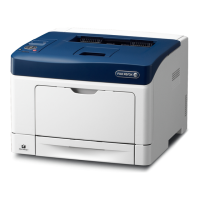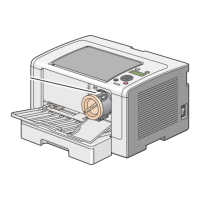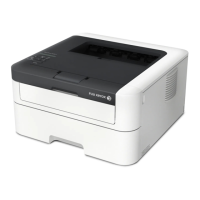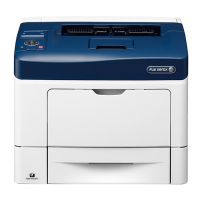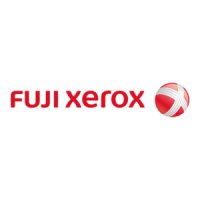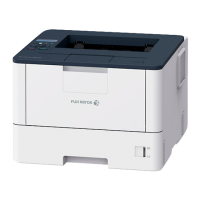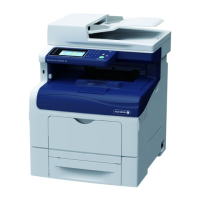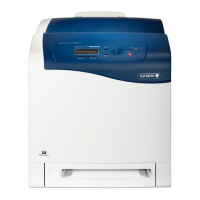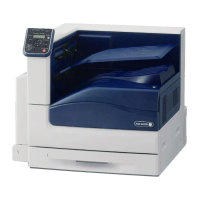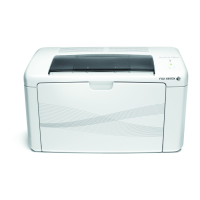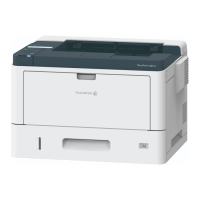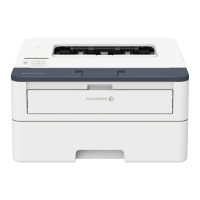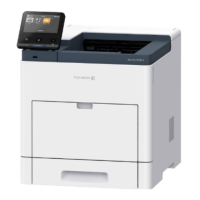
Do you have a question about the Fuji Xerox DocuPrint P505 d and is the answer not in the manual?
| Print Technology | Laser |
|---|---|
| Print Speed (A4) | Up to 50 ppm |
| Print Resolution | 1200 x 1200 dpi |
| Paper Output Capacity | 500 sheets |
| Operating Systems Supported | Windows, macOS, Linux |
| Connectivity | USB 2.0, Ethernet |
| Paper Capacity (Standard) | 550 sheets |
| Media Sizes Supported | A4, A5, B5, Letter, Legal |
| PDL (Page Description Language) | PostScript |
Introduces the guide and lists the types of manuals provided with the machine for user assistance.
Provides essential security warnings and recommendations for safe and secure operation of the machine.
Explains how to use the guide and details the organization of chapters, including symbols, terms, and formatting conventions.
Details how to connect the printer to a computer or network, covering Ethernet, USB, and wireless connections.
Provides instructions on how to turn the printer on, off, or put it into sleep mode.
Guides users through the initial setup wizard on the control panel for language, date/time, and measurements.
Details the steps and specifications for setting up the printer's wireless LAN connection using the optional Wireless LAN Kit.
Explains the wireless network settings required for setup, advising users to contact their network administrator for details.
Explains how to assign IP addresses (IPv4/IPv6) to the printer using the control panel or CentreWare Internet Services.
Describes methods to confirm the IP settings of the printer, either via the control panel or by printing a configuration report.
Explains the necessity and procedure for installing printer drivers on a computer to enable printing.
Describes the printer's physical components, showing front and rear views with labeled parts.
Details the control panel components, including the touch screen, buttons, and status LED.
Illustrates optional components like the Finisher, 4-Bin Mailbox, High-Capacity Feeder, Cabinet, and Caster.
Explains basic touch panel operations like selecting items, scrolling, and using the on-screen keyboard.
Guides users on how to change the language and keyboard layout settings on the touch panel.
Explains how to configure the printer's power saver modes, including low power and sleep timeouts.
Details the types of paper supported, loadable quantities, weight specifications, and recommended paper.
Provides guidelines on proper paper storage to maintain quality and prevent issues like jams or warping.
Provides step-by-step instructions for loading paper into Trays 1 to 5, including adjusting paper guides and covers.
Details the procedure for loading paper into the printer's bypass tray, including extending the tray and adjusting guides.
Explains how to load paper into the optional High-Capacity Feeder tray, including adjusting guides and verifying settings.
Defines how the printer behaves during paper conflicts or mismatches, configuring behavior for trays 1-5 and the High-Capacity Feeder.
Provides guidelines for printing on special paper types, focusing on envelopes and their proper loading and driver settings.
Offers guidelines for printing labels, including proper storage, handling, and selecting 'Label' as the paper type in the driver.
Explains how to send a print job from an application, including selecting preferences and sending the job to the printer.
Describes methods for canceling print jobs from the control panel or a computer, via the Jobs screen or banner.
Explains how to perform duplex (two-sided) printing on both Windows and OS X systems, including selecting binding options.
Details how to enable and use the booklet print feature, noting driver requirements and duplex settings.
Explains how to store print jobs in the printer's memory for later printing from the control panel, covering Secure Print and Sample Set.
Describes how to print files directly from a USB flash drive, listing supported file formats and the printing procedure.
Provides information and setup procedures for printing directly from Wi-Fi mobile devices using Wi-Fi Direct, without an access point.
Covers mobile printing capabilities, including setup for AirPrint on iOS and OS X devices.
Explains how to enable and use Google Cloud Print™ for printing via the Google Chrome™ browser without installing drivers.
Details how to set up and use Mopria™ Print Service for printing from Android devices, enabling connection via network or Wi-Fi Direct.
Covers device management features like language, keyboard layout, about information, and notifications, including fault history.
Details the status of supplies, billing information, usage counters, and general settings like measurements and paper size preference.
Covers settings for date/time, system timeout, display brightness, sound notifications, and power saver modes.
Details network connectivity settings, including Ethernet (IPv4/IPv6) and Wi-Fi configurations, primary network interface selection, and rated speed.
Details 802.1X settings for authentication and Wi-Fi configuration, including SSID, security types, Wi-Fi band, and Wi-Fi Direct.
Covers TCP/IP settings (Host name, IPv4, IPv6, DNS) and Security settings (Encryption, Passcode, Authentication Method, Certificates).
Details USB interface settings, print modes, auto job timeout, Adobe communication protocols, and PostScript wait timeout.
Covers Wi-Fi Direct settings, including enabling the feature, paired devices, roles, SSID, DHCP server, and group owner settings.
Details Near Field Communication (NFC) enablement and mobile printing features like AirPrint, Google Cloud Print™, and Mopria™.
Configures network protocols including Bonjour, HTTP, HTTPS, CSRF Protection, and Proxy Server settings for secure and efficient communication.
Details the configuration of IPsec settings for secure network communications, including authentication methods and certificates.
Guides on configuring LDAP server settings, including specifying destination addresses (IPv4/IPv6) and server details for directory access.
Details LDAP authentication settings, including advanced options, common name, login user name, and custom filters for user identification.
Covers configuration for LPD, TCP-MSS protocols, including port settings, print modes, timeouts, and spooling options.
Details settings for Port 9100, SMB server address acquisition, and SMTP email notification configuration.
Covers SNMP configuration for network management, including port settings, traps, SNMPv1/v2, and SNMPv3 settings.
Details SNMPv3 settings for secure network management and trap destination registration for network alerts.
Covers SNTP for time synchronization, SOAP port enablement, and Web Services on Devices (WSD) Print configuration.
Details procedures for transfer voltage, density adjustment, toner refresh, and various reset options to restore factory defaults.
Covers support pages for printing reports, altitude adjustment, non-genuine toner, cleaning procedures, and image/fusing unit adjustments.
Provides an overview of encryption and digital signature features, explaining certificate types and their use in securing communications.
Explains how to encrypt HTTP communications using SSL/TLS and IPsec, including certificate requirements and setup.
Details the steps to configure HTTP communications encryption on the machine and computer, including certificate setup.
Explains the procedure for importing and configuring certificates for IPsec encryption, along with computer-side configuration.
Guides on configuring Wireless LAN WPA-Enterprise with EAP-TLS, involving certificate import and setting EAP identity and authentication method.
Explains user types (System Administrator, Login User, Unregistered User) and roles for controlling permissions and access to printer features.
Describes types of authentication (User ID, Simple, Network) and account administration methods like Xerox Standard Accounting.
Covers network accounting, authentication/accounting relationships, and procedures for logging in/out of the printer and CentreWare Internet Services.
Details the process of creating new user accounts and editing existing ones through CentreWare Internet Services for managing user access.
Explains how user authentication is applied for accounting purposes in Xerox Standard and Network Accounting systems, including feature tracking.
Lists the machine's consumables and periodic replacement parts, including product codes and quantities, with important safety warnings.
Explains how to check supplies status via the control panel and provides detailed steps for replacing the toner cartridge.
Provides instructions on how to replace the drum cartridge, including opening the front door and handling the cartridge correctly.
Details the procedure for replacing the staple cartridge when the optional finisher is installed and a message indicates replacement is needed.
Provides instructions for cleaning the exterior of the machine monthly, emphasizing the use of recommended materials and avoiding liquids.
Explains how to clean the touch screen monthly using a damp cloth, followed by a dry cloth, and how to handle stubborn stains.
Details the procedure for cleaning the LED lens block using a cleaning tool to remove debris and toner dust for better print quality.
Explains how to adjust paper registration to fine-tune printed image placement on the page, including verifying and printing sample pages.
Describes how to adjust the transfer roller voltage to improve print quality, especially for light or mottled images, based on paper type.
Guides on adjusting the fusing unit temperature to prevent toner smearing or ensure proper fusing, depending on paper type.
Covers adjusting the printer's altitude setting for print quality and performing a developer/transfer roller cleaning to reduce background toner.
Explains how to adjust print density for lighter or bolder output and how to perform toner refresh to recalibrate toner concentration.
Provides step-by-step instructions for safely removing the optional High-Capacity Feeder, including powering off and disconnecting cables.
Details the procedure for removing the optional caster component from the printer, following safety precautions.
Provides instructions for removing the optional finisher, including powering off, disconnecting cables, and opening the rear door.
Details the procedure for removing the optional 4-Bin Mailbox, including powering off, disconnecting cables, and opening the rear door.
Provides a flowchart to diagnose and solve common printer issues, guiding users to specific sections based on symptoms like 'Machine does not work properly' or 'Image quality is poor'.
Addresses common machine issues such as the printer not powering on, dark touch screen, or paper feed problems, offering specific causes and remedies.
Troubleshoots issues related to paper jams, wrinkles, improper stacking, and error messages from the bypass tray, providing causes and remedies.
Guides users to identify and resolve image quality issues like faint prints, smudges, black dots, or lines by checking paper dampness or replacing cartridges.
Addresses image quality problems such as dirt intervals, white dots, smudged toner, unfused toner, soiled paper, and solid black areas.
Troubleshoots issues related to white patches, text or images printed at an angle, caused by drum or toner issues, or incorrect paper guide settings.
Provides solutions for unable-to-print scenarios, covering issues like machine power, network connectivity, IP settings, transport protocols, data format mismatches, and paper status.
Helps diagnose and resolve issues where the print result is unexpected, such as missing edges, incorrect fonts, no offset, or black lines.
Addresses common network printing issues when using TCP/IP, covering causes and remedies for inability to print due to IP address, data volume, or protocol mismatches.
Provides solutions for problems encountered when using CentreWare Internet Services, such as connection errors, distorted display, or settings not applying.
Troubleshoots issues when connecting to the Internet or intranet, covering authentication, remote linkage services, IP address, DNS, and proxy server problems.
Addresses common issues with IPv4 and IPv6 connections, including problems with address formatting, link-local addresses, and computer connectivity.
Lists error codes from 005-001 to 011-999, providing the cause and recommended remedy for each error encountered.
Lists error codes from 012-001 to 012-999, often related to finisher malfunctions.
Lists error codes from 013-001 to 015-999, typically indicating general machine errors requiring power cycling or support contact.
Lists error codes from 016-001 to 016-999, typically indicating software or general machine errors.
Lists error codes from 016-234 to 016-345, typically indicating general machine errors requiring power cycling or support contact.
Lists error codes from 016-347 to 016-403, often related to authentication or network connection timeouts.
Lists error codes from 016-404 to 016-425, typically indicating general machine errors requiring power cycling or support contact.
Lists error codes from 016-427 to 016-456, often related to IP address duplication or DNS server issues.
Lists error codes from 016-500 to 016-517, typically indicating EP system connection or communication errors.
Lists error codes from 016-517 to 016-535, typically indicating EP system connection or communication errors.
Lists error codes from 016-533 to 016-546, often related to Kerberos authentication or authentication software issues.
Lists error codes from 016-548 to 016-560, often related to authentication software or communication errors.
Lists error codes from 016-562 to 016-573, often related to USB memory device issues or insufficient memory.
Lists error codes from 016-700 to 016-715, often related to job ticket issues, memory limitations, or unsupported features.
Lists error codes from 016-716 to 016-732, often related to PDF or TIFF processing, or unsupported printer features.
Lists error codes from 016-733 to 016-749, often related to email sending, document attachments, or booklet creation.
Lists error codes from 016-750 to 016-758, often related to PDF or XPS processing, password issues, or service permissions.
Lists error codes from 016-759 to 016-792, often related to SMTP server errors, email address issues, or job history.
Lists error codes from 017-001 to 017-999, typically indicating job limit server errors or SMTP server issues.
Lists error codes from 018-001 to 020-999, often related to IPsec settings or LDAP authentication.
Lists error codes from 021-001 to 022-999, primarily related to EP system connection and communication issues.
Lists error codes from 023-001 to 025-999, often related to memory, paper type, or jam conditions.
Lists error codes from 026-001 to 026-999, often related to DocuWorks processing, USB device issues, or EP system connectivity.
Lists error codes from 027-001 to 032-999, covering various issues including IP address duplication, authentication, and server connectivity.
Lists error codes from 027-447 to 027-714, often related to SMTP server errors or certificate issues.
Lists error codes from 027-715 to 027-735, often related to SMTP server issues or SSL settings.
Lists error codes from 027-736 to 027-754, often related to certificate validation or job flow processing.
Lists error codes from 027-757 to 027-761, often related to LDAP authentication or server connection issues.
Lists error codes from 027-762 to 027-794, often related to WebDAV server issues or certificate validation.
Lists error codes from 027-795 to 029-705, often related to WebDAV or Wi-Fi errors, including proxy configuration.
Lists error codes from 029-706 to 029-717, often related to Wi-Fi or proxy auto-config file errors.
Lists error codes from 041-001 to 044-999, typically indicating general machine errors requiring power cycling or support contact.
Lists error codes from 045-001 to 046-999, typically indicating general machine errors requiring power cycling or support contact.
Lists error codes from 047-001 to 047-999, typically indicating general machine errors requiring power cycling or support contact.
Lists error codes from 055-001 to 059-999, typically indicating general machine errors requiring power cycling or support contact.
Lists error codes from 059-001 to 059-999, typically indicating general machine errors requiring power cycling or support contact.
Lists error codes from 060-001 to 060-999, typically indicating general machine errors requiring power cycling or support contact.
Lists error codes from 061-001 to 061-999, typically indicating general machine errors requiring power cycling or support contact.
Lists error codes from 071-001 to 076-999, mostly related to tray malfunctions or unsupported optional feeders.
Lists error codes from 077-001 to 077-999, typically indicating general machine errors requiring power cycling or support contact.
Lists error codes from 081-001 to 091-999, typically indicating general machine errors requiring power cycling or support contact.
Lists error codes from 092-001 to 092-999, typically indicating general machine errors requiring power cycling or support contact.
Lists error codes from 093-001 to 093-999, typically indicating general machine errors requiring power cycling or support contact.
Lists error codes from 099-001 to 101-999, typically indicating general machine errors requiring power cycling or support contact.
Lists error codes from 102-001 to 115-999, typically indicating general machine errors requiring power cycling or support contact.
Lists error codes from 116-001 to 116-999, often related to memory issues, unsupported features, or print data problems.
Lists error codes from 116-701 to 116-724, often related to memory, paper settings, or print data issues.
Lists error codes from 116-725 to 116-747, often related to memory, paper settings, or print data issues.
Lists error codes from 116-748 to 116-790, often related to email sending, document attachments, or booklet creation.
Lists error codes from 117-001 to 117-999, typically indicating general machine errors requiring power cycling or support contact.
Lists error codes from 118-001 to 122-999, typically indicating general machine errors requiring power cycling or support contact.
Lists error codes from 123-001 to 126-999, typically indicating general machine errors requiring power cycling or support contact.
Lists error codes from 127-001 to 132-999, typically indicating communication errors between the machine and a print server.
Provides remedies for general error messages like 'A fault has occurred' or 'Completed with an error', guiding users on basic troubleshooting steps.
Explains how to clear paper jams, including safety precautions for the fusing unit and heat roller, and how to remove torn paper.
Provides step-by-step instructions for clearing paper jams that occur in the bypass tray, including removing trays and adjusting guides.
Details the procedure for clearing paper jams occurring in Tray 1, involving removing the bypass tray and Tray 1 itself.
Provides instructions for clearing paper jams that occur in Trays 2 to 5, involving pulling out trays and removing crumpled paper.
Explains how to clear paper jams in the fusing unit, including safety warnings about the hot unit and lifting the paper guide.
Provides steps to clear paper jams from the finisher by locating and opening the jam-access door and following control panel instructions.
Details how to clear paper jams from the 4-Bin Mailbox by locating and opening its jam-access door and following control panel instructions.
Lists the basic specifications of the printer, including type, printing method, warm-up time, print speed, resolution, colors, and paper sizes supported.
Provides specifications for optional components like feeders and finishers, paper weight limits, tray capacities, and output tray capacities.
Lists printer memory, supported PDL (Page Description Languages), and the operating systems compatible with the PCL and PostScript drivers.
Details interface types, protocols, power supply requirements, noise levels, power consumption, dimensions, weight, and operating environment conditions.
Provides detailed specifications for the High-Capacity Feeder, 4-Bin Mailbox, and Finisher, including paper size, weight, capacity, and dimensions.
Details the finisher's capabilities, including stacker capacity, staple specifications (capability, paper size/weight), and dimensions/weight.
Lists available optional components for the printer, such as feeders, cabinet, caster, finisher, wireless LAN kit, and HDD extension kit, with brief descriptions.
Introduces the Electronic Partnership (EP) system for automatic machine control and maintenance, outlining its services like meter reading and software upgrades.
